Three miles up
A high-altitude expedition to Bolivia
 As you climb higher up a mountain, the air gets progressively thinner. By the time you reach an altitude of 5000 metres (16,000 feet) - around the height of the tallest peaks in Europe and North America - the atmospheric pressure has dropped to only half that at sea-level. A human being at that height is therefore only inhaling half the normal amount of oxygen. Ascending to such altitude presents the body with immense physiological challenges, and can cause serious illness in certain individuals.
As you climb higher up a mountain, the air gets progressively thinner. By the time you reach an altitude of 5000 metres (16,000 feet) - around the height of the tallest peaks in Europe and North America - the atmospheric pressure has dropped to only half that at sea-level. A human being at that height is therefore only inhaling half the normal amount of oxygen. Ascending to such altitude presents the body with immense physiological challenges, and can cause serious illness in certain individuals.
However, due to the challenges involved in conducting research on top of mountains, the changes that occur in the body at altitude are still poorly understood. In particular, it remains largely unknown why some individuals tolerate altitude well while other people, who may seem equally fit and healthy at sea level, rapidly develop so-called Acute Mountain Sickness (with symptoms such as headaches, dizziness and nausea), which may lead in certain cases to life-threatening illnesses, including pulmonary oedema (fluid on the lungs) and cerebral oedema (fluid on the brain).
Apex (Altitude Physiological Expeditions) was set up in order to help answer these important questions. Originally conceived by a group of medical students from the University of Edinburgh, it is a Scottish charity dedicated to conducting cutting-edge medical research at high altitude. In 2001, on the first Apex expedition, around 20 doctors and students set off for Chacaltaya in Bolivia, home to one of the world's highest laboratories: 5200 metres (17 000 ft) above sea level. This first expedition was a great success, but in order to get a much better understanding of the different ways in which different people respond to altitude, it was decided to conduct a second expedition on a much larger scale. In 2003, therefore, a second Apex Altitude expedition was carried out, this time involving over a hundred people, split into five teams.
There were many elements to the medical research. Exercise tests, cognitive studies and ultrasonic heart scans were carried out to compare how our bodies and brains functioned at sea level with how they functioned on top of the mountain. Some volunteers spent nights wired up to sensors in order to monitor their sleep patterns. Blood tests were done to find out if a person's genetic make-up had any influence on ther ability to cope with altitude. A drug trial was also carried out, in which the volunteers were divided randomly and blindly into three groups. Members of one group were given vitamin supplements, members of the second group were given Viagra (seriously) and the rest were given a placebo. Measurements and samples taken from the three groups were compared to find out if the drug or the vitamins helped the body to cope with altitude.
I applied to join Apex II during my first term as a biology student at Edinburgh University, and was put on Team 4 of the expedition. The team consisted mostly of fellow students from Edinburgh, but also included a group of four medical students from Oxford, and a student from Wales who was studying marine biology but mysteriously decided to come on a high-altitude medical expedition to a landlocked country. We were led by the fearless Dave, a second-year Geography student with plenty of expedition experience and an enviable collection of top-quality survival gear - the kind of guy who is handy to have around whenever you need to borrow a knife or a tin opener.
The expedition lasted for a month; part of this time was spent conducting research at the laboratory, and the rest was spent travelling around Bolivia. Although many people associate the country merely with cocaine and political instability, in fact it is a beautiful and friendly place, with an astonishing range of landscapes - from icy peaks, barren deserts and vast mountain lakes down to steaming jungles and the wide grasslands of the pampas.
Bolivia is also well known for its regions of high altitude, making it an ideal destination for the Apex expedition. The south-west of the country is straddled by the giant peaks of the Andes and the high, chilly plain of the altiplano. La Paz, Bolivia's de facto capital, is the world's highest capital city - its upper suburbs are over 4000 metres (13 000 ft) above sea level, three times the height of Britain's tallest peak. The mountains of the Cordillera Real, surrounding La Paz, tower to well over 6000 metres (20 000 ft) - a height unrivalled almost anywhere except in the Himalayas and elsewhere in the Andes.
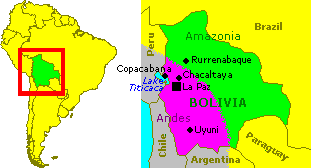
In late summer, 2003, our team departed for Bolivia...
1 September
After a long and exhausting weekend of plane flights, during which I got about five hours sleep in three days, we've arrived in La Paz. Along the way I got to enjoy a few brief hours of subtropical bliss at the outdoor swimming pool and health club on the roof of Miami airport. At 5.30 a.m. yesterday the plane finally slammed into the runway at La Paz (at twice the usual speed, to avoid the plane stalling in the thin air).
La Paz is one of the most visually stunning cities I have seen - it makes Edinburgh look like a clump of molehills by comparison. The airport is on a high plain above the city, at an altitude of over 4000 metres (13 000 ft), and as we left the airport we could look across the yellow altiplano to where the rising sun was illuminating icy mountain tops that rose above the plain like a stage backdrop. The bus journey down into the city was even more breathtaking. La Paz is built in a vast canyon, with houses like cubes of concrete adorning the sides. Behind the city, ranges of colossal mountains were rising out of the mist.
Although La Paz is shabby by Western standards, and the suburbs that rise up the canyon walls like a cartoon background are distinctly Third World in appearance, the city centre is surprisingly pleasant and modern, with some impressive architecture. The city is bustling with people, yet it has a strange peacefulness and serenity about it.
The combination of low latitude and high altitude gives La Paz a bizarre climate. In the shade the temperature is like that of Britain in winter, but overhead there is a scorching tropical sun. This makes it very hard to dress appropriately - in the sun you can be hot in a T-shirt and shorts, yet a metre away in the shade you can shiver in a winter fleece.
Our Apex team (sixteen of us) are staying in a hostel in the city centre - a smart place with all mod cons (except central heating, which is sorely needed) built around an attractive Mediterranean-style courtyard. Apparently the building was once home to a former president, although in a country that's seen 190 presidents in 160 years of turbulent history, such places probably abound.
One of the best things about Bolivia is that it is incredibly cheap - last night we all went out to a plush restaurant at a cost of about three quid ($5) each, including the taxi there and back. Accommodation, transport, and Internet access are similarly cheap. Ironically, the low prices sometimes make it difficult to spend money, because hardly anything costs more than a few bolivianos and nobody has change for the 100-boliviano notes (about £10/$16) that are dispensed by cash machines.

The real Diagon Alley - the "Witches' Market" in La Paz
Since I'm virtually incapable of sleeping in late, even when exhausted and jet lagged, I've been able to make myself useful to the team by taking on the job of rousing everybody at 8 a.m. to remind them to take their morning medication. ("Viagra time!") To avoid introducing uncertainties into the research, the pills have to be taken at precise times of day.
As for the altitude, the only effect so far has been a feeling of being slightly light-headed. My blood oxygen saturation has gone down from 99% to 94%, and my heart rate has risen from 72 to 92 beats per minutes. These are fairly normal responses to altitude. Any physical exertion leaves you rapidly exhausted here (La Paz is an annoyingly hilly city to walk around), and last night I was kept awake by the sounds of abnormally heavy breathing, but most of the time I don't notice the effect of the altitude. We're still only at 3600 metres (12 000 ft), however - far below the 5200 metres (17 000 ft) of the laboratory. Apart from a few headaches, nobody else has yet been badly affected either.
2 September
I spent yesterday exploring La Paz with various Apex team mates. There are some amazing markets selling everything from pirated DVDs to dead llama foetuses (according to local superstition, these are good luck charms!). In the morning I was in a T-shirt wishing I'd applied more sunscreen. Two hours later it was sleeting. I seem to have acclimatised a bit to this altitude now, and can walk around La Paz at the same pace as I would in Edinburgh, albeit panting breathlessly all the way.
4 September
The day before yesterday the whole of our Apex team set off on a trip to Lake Titicaca, on the Peruvian border west of La Paz. The four-hour bus journey there took us across the altiplano, an unbelievably inhospitable environment - barren, rocky, arid, and scorched by a tropical sun while simultaneously blasted by icy winds. The incredible thing is that people manage to live on this virtual wasteland - almost everywhere there were signs of habitation.
Lake Titicaca looks and feels just like the sea. It is hard to believe that it is actually a vast freshwater lake, about 150 miles (240 km) long and nearly 4000 metres (13 000 ft) above sea level. The bus from La Paz took us to the pleasant little town of Copacabana - the closest thing that landlocked Bolivia has to a seaside resort - and from there we caught a boat across to the island of Isla del Sol.
Isla del Sol was regarded by the Incas as the birthplace of the sun, and is home to some interesting ruins and ancient sites. The island has a Greek feel to it (Lake Titicaca has been compared with the Aegean): it is dry and barren, yet quite beautiful nonetheless. There are several villages around the island, consisting of dilapidated huts with donkeys and pigs running around. We hiked the length of the island - several miles, which left us extremely breathless at the altitude - and stayed overnight in a basic hostel by the beach. By day the sun was roasting and Isla del Sol did feel almost like a tropical island, but at night the icy wind and thundery showers howling off the water were more reminiscent of Scotland.
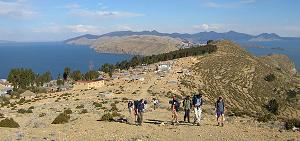
Trekking over Isla del Sol, with Lake Titicaca in the background
The next morning we explored the Inca ruins at the northern end of the island, then got a boat back to Copacabana (via the smaller island of Isla de la Luna), from which we returned by bus to La Paz.
Apart from being breathless when I exert myself, I now feel absolutely fine at this altitude. I notice strange little things, however - hot drinks are cooler (because water boils at a lower temperature), beer froths more violently, candles seem to burn with a more elongated flame, and the pigeons that swarm all over La Paz have to flap much harder than normal in order to stay aloft.
12 September
Tropical summer has arrived in Bolivia, bringing early morning flurries of snow to La Paz...
I'm now back down in the city, having survived the week at Chacaltaya laboratory. In fact I coped relatively well with the altitude, and apart from a couple of afternoons of horrendous exhaustion I was able to lead a relatively, normal active life.

Chacaltaya laboratory, with the nearby ski station in the background
At 5200 metres (17 000 ft), the lab is at three-fifths the height of Mt Everest, and the air there is half as thick as at sea level. When resting the lack of oxygen isn't too noticeable (although the volunteers' blood oxygen concentrations dropped to levels that would probably have rung alarm bells in a hospital ward), but any kind of physical exertion leaves you agonisingly short of breath. It gives you an interesting feel for the amount of oxygen that the body uses for different tasks. Lowering yourself into bed, for instance, is actually quite an energetic process (breathless at altitude). Running upstairs (in fact running anywhere) is seriously exhausting. Perhaps this is what it's like to be elderly.
Inside, the laboratory at Chacaltaya, which is normally used for cosmic ray physics, is run-down and primitive. The toilet stinks and has to be bucket-flushed, the electric showers give off bright green sparks and the occasional shock, snow falls through the roof in places (and cascades off noisily elsewhere) and the whole building is freezing cold. However, the scene outside is stunning. On one side there are views down to the altiplano (approximately a mile below), which is illiminated at night by the lights of La Paz's upper suburbs. In the other direction are majestic snow-capped Andean peaks, including the spectacular 6000-metre (20 000 ft) summit of Huayna Potosi.
Several times we climbed up to the summit of Chacaltaya mountain (5395 m / 17700 ft) - a breathless, lung-shattering ascent, but rewarded with utterly stunning views. From the top of the mountain, we saw clouds rolling across the Amazon basin, and in the other direction, the shining expanse of Lake Titicaca. The feeling of being on top of the Andes is magical, especially at night in the moonlight.
While samples and measurements were being carried out, we were forbidden any kind of drugs, including alcohol, caffeine or chocolate. However, on the days when we weren't being sampled, we visited the dilapidated nearby ski lodge - the world's highest - for a hot chocolate or mulled wine.
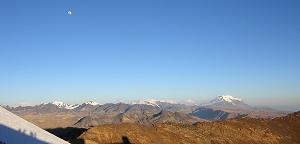
The moon over Chacaltaya ski slope at sunset
On some days it snowed on the mountain; on others, the sky was tropical blue and the sun burned off the snow. It was permanently cold, however, and the windchill was intense. No vegetation survives on Chacaltaya, but the loose, slaty material of which the mountain is composed is rich in marine fossils.
When we weren't being sampled, or climbing the surrounding ridges, we amused ourselves by watching DVDs, reading books, and playing table football. (Anyone who lost 10-nil at the latter had to run around the lab outside in the snow in their underwear.)
Now the research is over, I'm free to do what I want - eat chocolate, drink alcohol, sample coca, and go down to lower altitudes if I wish. I'm not too bothered about drinking, and I've yet to develop a taste for cocaine. The lifting of the chocolate restriction is welcome, however (there are some wonderful cakes in the cafes of La Paz), and being able to descend to the Amazon is certainly a bonus. So, while most of my teammates are planning on spending their free time climbing barren mountains, I've joined forces with a couple of altitude-sick Welsh volunteers from my Apex team and planned a trip to the jungle. We booked flights, bought anti-malarial pills from a local pharmacy (stuff you'd need a prescription for in Britain), and we leave tomorrow.
19 September
The team made good use of the extra evening we spent in La Paz, when our flight to the Amazon was delayed due to weather. After setting out in search of a cheap fast food cafe, there was a lot of arguing and disorganisation with regard to where we wanted to have dinner, and we somehow ended up in the 5-star restaurant on the top floor of Hotel Presidente. This plush restaurant, one of the best in the country, is at the top of a 16-storey tower in the city centre, surrounded by windows. On either side the lights of La Paz twinkled up the hillsides; the place felt like a scene out of the Jetsons. We were the only people in the entire restaurant (had there been anyone else there to notice, we probably wouldn't have got in with our dirty trainers, creased trousers and casual Apex fleeces!). The bill for the luxurious meal, including wine, came to less than it did the last time I went to Pizza Hut in Edinburgh!
The next day the two Welsh team members and I got up at 5 a.m. to catch the flight to Rurrenabaque in the Amazon, only to spend five hours sitting in La Paz airport watching the snow before the weather cleared sufficiently to enable us to take off. My head spun as the unpressurised 12-seater plane climbed over the 6000-metre (20 000 ft) peaks of the Cordillera Real. The pilots got oxygen; the passengers didn't. After crossing the mountains we descended, and descended, and descended, passing over a vast green expanse of utterly uninhabited wilderness. A water bottle that I'd opened and resealed in mid-flight was crushed as though it had been stamped on when we landed.
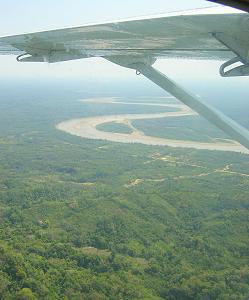
Amazonia from the air
After the cold and airlessness of La Paz, landing in Rurrenabaque was like a wonderful dream. As I stepped out of the cramped plane onto the sunlit airfield, an irridiescent blue butterfly the size of my hand fluttered past.
Rurrenabaque is a dusty but atrractive little frontier town, set in the jungle on the shores of the Rio Beni - a river that is the size of the Thames in East London but is merely a small tributary of the mighty Amazon. Behind the town rises a steep ridge of forest-draped hills; the river flows through these in a gorge. The hostel we stayed in had an attractive courtyard with hammocks in which to relax during the heat of the day. At night we joined the rest of the tourist community for delicious cocktails and bowls of banana chips in the 'Jungle Bar'.
The next day we went on a tour into the jungle. We got on a large motorised canoe, passing through the gorge and into a region of jungle totally ringed by low mountains. It was the kind of place you might expect to find King Kong, or a Lost World of prehistoric monsters. However, all we saw were exotic birds (the area is home to over 1100 bird species).
[I later discovered that I wasn't the only one who speculated that King Kong might be found in such a place. In his book "The Monster of the Madidi", author Simon Chapman describes an expedition into the Bolivian jungle in search of a mythical giant ape.]
We continued up the river through the jungle, into the Madidi National Park. Here we stopped at a lodge where we got off the boat and went on a guided walk. Apart from some impressive trees, the most noticeable wildlife was the spiders and the insects - ants (including lines of leaf-cutter ants), butterflies, cockroaches, flies, termites, and so on. After lunch, we got the boat further upstream to where a huge muddy cliff rose above the jungle. We scrambled with great difficulty up a gulley in this cliff (two at a time, to avoid showering each others' heads with loose stones) and stood on top, watching the beautifully colourful macaws that nested in the cliff coming and going.
On the way back down to Rurrenabaque that afternoon, the boat ran out of petrol. We had fun paddling it with sandals, cold-box lids, etc, before another boat came past and gave us some fuel.
The next day we set out on a three-day tour of the pampas. This started out with a three-hour truck journey down unbelievably dusty roads. At one point we saw a sloth in a tree by the roadside; later we saw some toucans flying past. Eventually we arrived at a muddy river, where we got in another motorised canoe. The river was teeming with life - including numerous alligators, caimans, turtles, capybara, and some friendly yellow monkeys that boarded our boat to take bananas. The many exotic birds included eagles, vultures, herons, storks, cormorants, and the bizarre hoatzin (a unique turkey-sized creature considered a living link between birds and dinosaurs because its chicks retain claws on their wings).
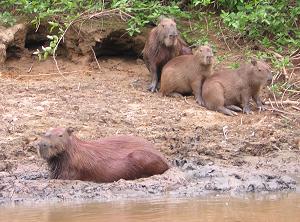
Capybara by the river in the pampas
After a couple of hours, we arrived at the lodge where we would be spending the next two nights. Although the pampas is mainly open grassland, by the river there are clumps of forest, and the wooden lodge was surrounded by trees. A large alligator lurked permanently in the river below. At night, the riverbank opposite twinkled with fireflies. We went by boat to a local cattle ranch (the only permananet habitation for miles around) to watch the crimson red sunset over the pampas. After dinner (spaghetti bolognese with a side dish of fried piranha) we had a choice of staying indoors with the fellow Brits who were also using the lodge, drinking copious quantities of beer (purchased from the enterprising rancher) while playing a card game called 'sh*tter', or going for a walk outside in the pitch blackness with giant poisonous cockroaches and a marauding alligator. We chose the latter.
The next day we went for a walk across the pampas. Striding through the metre-high grasses, you can easily appreciate why humans (which evolved in a similar environment - the savannahs of Africa) walk upright. When we arrived at a swamp we went searching for anacondas, by the interesting method of wandering about in the black foot-deep water in our boots until we accidentally trod on one of the killer snakes. Our guide found a juvenile (about a metre long) and it was handed to me. I could feel the coils of muscle power writhing through the snake. I managed to hold it so that it couldn't constrict me - so it bit me instead. Anacondas aren't venomous, but I now have some nice tooth marks on my finger.
That afternoon we went down the river to swim in a pool that was home to two river dolphins. We cautiously followed our guide into the brown water, after being assured that the alligators (which were smaller than their Floridian cousins) weren't "agresivo". The dolphins popped up frequently but never came closer than a few metres from us. A troop of capuchin monkeys came up to the far shore. I wanted to swim over but didn't dare disturb the large alligator that was reclining on the bank nearby.
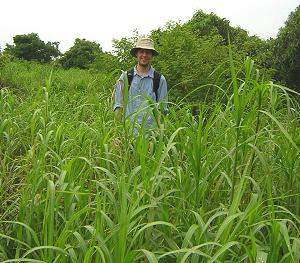
Trekking through the long grass of the pampas
That evening we watched the sunset again, then went for a starlit boat trip to watch alligators. They are more active at night, and their eyes glow orange by torchlight.
The next morning, before returning to Rurrenabaque, we went piranha fishing. We put bits of meat on hooks, and as soon as we lowered them into the river (the same river we'd swum in the day before!) the water churned with ravenous fish - not just piranhas, but many different kinds. Hooking them was a challenge, though, and removing a hook from the evil serrated mouth of a not-quite-dead piranha is definitely a job for the experts.
The flights from Rurrenabaque back to La Paz were disrupted due to rioting in La Paz. Political rioting is an ongoing thing in Bolivia. Three people were able to fly back in the morning, but one of us had to be delayed until the afternoon. I volunteered. I spent the morning paddling up the river in a rickety wooden kayak that I rented off an American hippie living in the back streets of Rurrenabaque. The guy had made the kayak himself; he also did delicious home baking. I left with a cinnamon roll and a leaflet about Jesus.
I returned to La Paz this afternoon without incident, although the roads are eerily quiet after the morning's disturbances.
20 September
Last night as I was going out to dinner with some of the others, we passed a lot of rioting. Loud explosions rocked the streets, local stallholders rushed to pack away their things before the crowds arrived, soldiers with evil-looking weapons were even more visible than usual, and I caught a throat-burning whiff of tear gas. I don't think we were in any serious danger, though. In fact, I suspect that the streets of La Paz might actually be safer on riot days because of the absence of traffic!
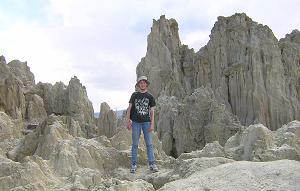
Among the amazing rock formations of the Valle de la Luna
Today everything is back to normal. I went with the other Andrew (the Welsh guy on our Apex team) to the suburb of Mallasa outside La Paz, where the locals were busy throwing potatoes at passing buses. The town is in a dramatic, arid canyon - hotter than the centre of La Paz (because of the slightly lower altitude) and reminiscent of Arizona or Australia. There we visited the city zoo (which was surprisingly good), and the Valle de la Luna - a set of impressive rock formations with tall spires, like organ pipes or termite mounds, interspersed with precipitous crevasses.
21 September
Last night I went out in La Paz with Team 5, who are celebrating their return from the lab and the lifting of all their chocolate and alcohol restrictions. Everyone got fairly drunk (I blame the altitude) and returned to the youth hostel in the early hours of the morning.
I got up bright and early later, feeling slightly sick - which I'm pretty sure was due not to alcohol, altitude or anything that I'd eaten, but to the fact that I'd agreed to go on a bike ride that day down "the world's most dangerous road". However, the ride wasn't as bad as I expected - in fact, it was fantastic. We'd decided to splash out and hire decent bikes with powerful front and rear suspension, which were an absolute dream to ride (potholes? what potholes?), although despite this were were pretty shaken up at the end of the day.
In total, the ride covered 67 kilometres (40 miles) horizontally (not as far as it sounds when you're going downhill all the way!) and three and a half kilometres (2 miles) vertically! We started at an altitude of 4700 metres (15 400 ft) - about the height of Mont Blanc, Europe's highest mountain - and finished at 1200 metres (4000 ft).

A section of mountain road between La Paz and Coroico
The first half of the ride was down wide, paved roads, and was an absolute joy. We let go of the brakes and sailed down the mountainside at terminal velocity - which was only about 25 mph (40 km/h), with a strong headwind blowing up the valley. It didn't feel that fast, perhaps because the air buffetting us was thinner than usual. Wisps of cloud drifted past, and in between them we caught glimpses of breathtaking scenery. It was an amazing feeling, cruising along the mountainside powered entirely by gravity.
The second half of the ride was along a narrow, stony dirt road, with a sheer thousand-foot (300m) precipice on one side. This is the notorious stretch of highway that the United Nations once described as the world's most dangerous road, because an average of two vehicles a month were disappearing over the edge into the abyss below. However, the road is far safer for cyclists (to whom the narrowness presents less of a problem), especially now that a safer alternative route has been constructed for vehicles and the old road is virtually empty.
It sounds horribly dangerous, but it didn't feel that bad (hundreds of tourists cycle the route every week and survive), and the scenery was stunning. Cycling so far down gave us a good appreciation of how the vegetation and landscape change with altitude. We started out in a barren mountain landscape, freezing cold. We progressed past stands of pampas grass, and tall ferns, down to hot tropical forests. The whole ride took about six hours, after which we got the bus back (up the safer new road) to La Paz.
26 September
I spent my final few days in Bolivia visiting the southwest of the country, together with most of the rest of Team 4 (who have finally come down from their mountaineering).
Southwestern Bolivia is a vast, arid wilderness (it's just across the border from Chile's Atacama Desert, one of the driest places on Earth), virtually uninhabited except for the bleak concrete town of Uyuni and a few small, desolate villages. In some ways it's a spectacular landscape, but it's very empty and monotonous. Like most of western Bolivia, the area is at very high altitude, but fortunately I'm now well acclimatised and scarcely notice the thin air.
The team got the overnight bus from La Paz to Uyuni: a 12 hour journey, mostly along dirt roads, which made for an extremely bumpy trip and caused the bus to fill with clouds of dust. Fortunately it was a huge bus and there was plenty of leg room. Earlier we had worried that we might not be able to get out of La Paz due to politically-motivated roadblocks, but that morning the president had got fed up with the protesters and sent in the army to clear the blocks. We arrived in Uyuni, shivering, at 5 a.m. - night-time temperatures in southwestern Bolivia can drop to -20°C (-4°F). After a brief rest, the team piled into three very rickety landrovers (I lost count of the number of changes of tyre we had over the next three days) and set off on a three-day guided tour of the southwestern deserts.
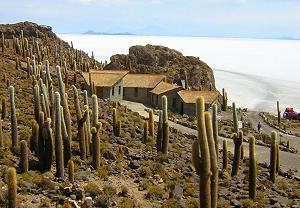
The Isla de los Pescadores, surrounded by salt
One of the highlights of the trip was the Salar de Uyuni - the remains of an inland sea that dried up to leave a flat plain, tens of miles across, whose surface is made entirely of salt. The place is surreal - zooming across the salt in the landrovers it felt as if we were in Antarctica. We stopped to visit a processing plant where they refine the salt for commerical use, and a hotel in which absolutely everything (except the roof) was made entirely of salt. The tour stopped for lunch (on tables made of crystalline salt) at the Isla de los Pescadores, a rocky outcrop sticking out of the salt, covered in phallic cacti. The sight of these cacti was truly weird, because it dispelled any notion that the white plain might be snow or ice.
[I bought some big packs of the local salt for a few pence each, figuring they'd make unusual souvenirs, and it only occurred to me later that I was carrying a large quantity of poorly-labelled white powder out of a notorious cocaine-producing country. Thankfully my luggage escaped the random searches being conducted at the airport.]
We sped across the empty salt plain at high speed for literally hours, beforecontinuing southwestwards into the desert. We spent the night at a little concrete village in the middle of nowhere.
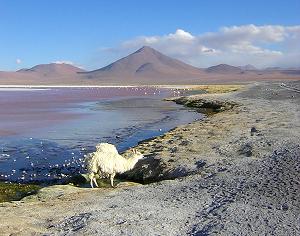
A llama beside the crimson waters of Laguna Colorado (with a flock of pink flamingoes in the background)
Over the next couple of days were visited mineral-rich lakes, many of them encrusted with salts and inhabited by flocks of beautiful pink flamingoes. Some of these lagunas were brightly coloured due to the presence of minerals or algae. We spent the second night in a primitive hostel beside the crimson Laguna Colorado, and on the following morning we visited the aquamarine Laguna Verde.
The landscape had now become more volcanic, with conical peaks sticking out of a greyish wasteland. On the third morning we passed steaming volcanic vents, reeking of sulphur, then stopped for a swim in a pool fed by a hot spring. The water was algae-filled and slightly sulphurous (it turned my hair bizarrely soft), but after having set off in the freezing cold before sunrise that morning, being able to relax in a warm bath was wonderful.

A salt lake adorns the volcanic landscape of southwestern Bolivia
The third afternoon was spent rushing at full speed along bumpy desert tracks back to Uyuni, so as not to miss the overnight bus back to La Paz (without which we would have had great difficulty in catching our flight back to London tonight). We made it back in time, and are now packing, ready for our flight, which leaves at 6 a.m. tomorrow morning. A leaving party has been organised for tonight, and most of team don't plan to sleep until they get on the plane.
[I got out of Bolivia just in time. A few days later, the political tension escalated - eventually leading to the removal of the president - and foreign tourists were evacuated from the country.]
This account of my trip is adapted from the various e-mails that I sent home.
Many thanks to everyone involved with Apex Altitude - especially to Dave and the other leaders who worked so hard to make the expedition possible, and the various sponsors who contributed to it.
See also...
Official Apex Altitude expedition web site
Hype magazine article on the expedition
Disclaimer - this is just my personal experience, it isn't a travel guide, nor is it intended to be an authoritative account of the Apex expedition. Not everything I did was necessarily safe and advisable, and details of the places I visited may change over time.